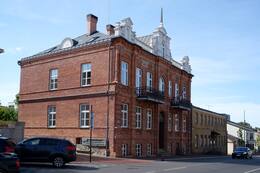Bloody floor in the basement of the Telšiai KGB
The memoirs of prisoners of the Telšiai KGB prison reveal horrific conditions of detention - from physical torture to inhuman living conditions in overcrowded cells.
"I regained consciousness only in Telšiai, in a KGB cell, on a bare-board cot," writes partisan Stasys Mockus-Kiaunė. The story of his hand being broken became one of the most brutal examples of interrogation methods - his hand was "cleverly inserted between the iron door frame and the door so that when it was closed, two fingers were simply crushed."
Partisan Aldona Gričiūtė-Saulė, arrested on October 5, 1947, remembers the nightmarish conditions of imprisonment: "There were nine of us women in the cell, and it was filthy and poor. You couldn't turn around on the cot, the end of it was boarded up high - it was a 'pillow'. Five of us had to lie here, and the rest - on the ground."
One day, two girls were taken out of their cell to clean the floor - there was blood everywhere. "They took out the dead one - she couldn't stand the pain," Gričiūtė-Saulė recalls. She herself could not sit because of the beatings, she rested on her knees and propped up on her elbows.
The hygiene conditions were terrible: "A bucket was placed nearby - a latrine. Less than a week later, my hands were covered in scabies. Later, all the soft parts of my body were infected with it. Rats were crawling all over my head." The prisoners made a rosary out of kneaded bread, to which they tied a medallion they had saved from their time in freedom, but the rat dragged that too into its cave.
The interrogations took place at night. "The interrogators talk about fishing, and you, man, stand in the corner and listen to the talk of the powerful. If you don't answer anything, you get hit with a rubber baton," Gričiūtė-Saulė testifies.
Related timeline
Related topics
Related objects
Former Telšiai Prison
The former Telšiai Prison building stands on Respublikos Street, in the central part of Telšiai city.
After the Telšiai fire of 1908, a private individual, a wealthy Jew named Neiman, built a neo-Gothic building in the historicist style. He agreed with the occupying tsarist authorities that he would build the building for the purpose of the district police board building that had burned down in the fire, according to the conditions specified by the authorities, and rent it to the authorities. It was one of the most beautiful buildings in Telšiai. During the First World War, the building was adapted for the Telšiai district prison. It was used as a prison both during the period of independent Lithuania (1918-1940) and during the Soviet occupation, until the beginning of the 1950s. In 1940-1941, 1944-1953, the building housed the NKGB–MGB–KGB Telšiai district internal prison.
On June 22, 1941, with the outbreak of the imperialist war between the Soviet Union and Nazi Germany, 162 prisoners were imprisoned in Telšiai prison – 76 NKGB interrogated prisoners. On June 23, there was an attempt to transport all the prisoners, but this plan failed because the local leaders of the Communist Party, the NKVD and the NKGB fled the city. No vehicles were provided for the transport of the prisoners. On the morning of June 24, 1941, Telšiai prison was surrounded by a unit of the 123rd Division of the 8th Red Army, and a three-judge court was hastily formed, headed by the NKGB Telšiai County Chief Petar Raslanas – so he, the Chairman of the Telšiai Executive Committee Domas Rocius and the Deputy Chief of the NKGB Kretinga County, State Security Lieutenant Yermolajevas, and others. All 76 political prisoners in Telšiai prison were sentenced to death. The other prisoners were released home. The short night of June 25th - dawn was already timidly breaking in the east when trucks with prisoners moved towards Rainiai. Three prisoners managed to escape from the trucks - unfortunately, they were soon caught by Red Army bullets... The mutilated bodies of 73 prisoners were accidentally found in Rainiai on June 28, 1941.
Later, the Telšiai Music School was located in the building, which operated here until 1994. Unfortunately, the building was severely damaged both externally and internally during the Soviet era.
During the restoration of the building, inside the walls, inscriptions of names, Gediminas' pillars, and various dates were discovered. Walled-up grottoes were also discovered.
On June 24, 1997, a memorial plaque was unveiled near the building by the Telšiai branch of the Lithuanian Prison Service, dedicated to the memory of 73 political prisoners of Telšiai Prison who were tortured in the Rainiai forest on the night of June 24-25, 1941.
In 2006, in memory of the 65th anniversary of the martyrdom of the Rainiai Martyrs, an artistic memorial plaque was unveiled near the former prison (author - Gintaras Gailius, architect - Algirdas Žebrauskas).





